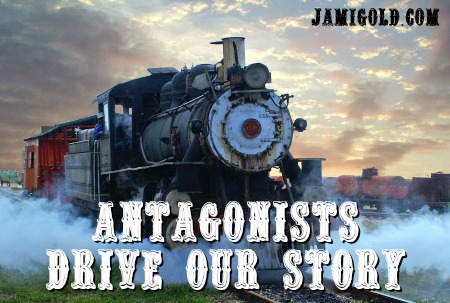Antagonists: What’s Driving Our Story? — Guest: Kristen Lamb

As I mentioned a couple of weeks ago, I’m currently dealing with more health-related difficulties, and I’m really hoping my surgeon won’t need to rip out the last year of work on rebuilding my jawbone due to instability. Keep your fingers crossed for me, as my follow-up appointment is this week. *smile*
To lighten my load, with her permission, I’m sharing some of Kristen Lamb’s insights on antagonists: what they are, why they help define our story, how to strengthen them, etc.
Three weeks ago, we started by exploring what antagonists are, and specifically what a story’s main antagonist is, what she calls the Big Boss Troublemaker (BBT). As she mentioned in that post, antagonists aren’t always a person or a villain.
Sometimes, we’ll say that a character is their own worst enemy, such as the “man versus self” story premise, and then use proxies of the BBT to provide a face for the opposition. Kristen also gave us an in-depth example of how outside characters can be a representation of our protagonist’s internal issues.
Last week, we examined how antagonists create our story. Knowing more about our antagonist—especially our BBT antagonist—can help us determine the right beginning and ending for our story and create the conflict that forces our protagonist to grow.
Today, we’re going to explore another type of antagonist in our story. If our BBT is just one type of antagonist and antagonists act as the conflict-engine for our story, what keeps the rest of our story going? Kristen’s going to teach us today about scene antagonists.
Please welcome Kristen Lamb once again! *smile*
*****
Scene Antagonists:
The Making of a Story and a Hero
A story’s structure and conflict are like two gears. Gears cannot turn unless there is another key wheel turning the opposite direction. No opposition, no power, no momentum. Same with a story.
Characters thinking and pondering does not a scene make. One bad situation after another is not conflict. As we covered last week, conflict is the core ingredient to fiction, and often you will hear this referred to as the antagonist.
The antagonist is the engine of your story. The antagonist provides the energy to move the story forward. Yet, the antagonist has many, many faces and that is what trips up most new writers.
Not All Antagonists are Villains
An antagonist is not necessarily a bad guy or villain. An antagonist merely has goals that conflict with what the protagonist wants.
Think of your antagonist like ice cream—infinite colors, flavors, and complexities. The antagonist is not always evil.
Villains are only a flavor of antagonist, much like chocolate is only one flavor of ice cream. And, even in chocolate, there are still limitless varieties. Guess what? Same with villains. We’ll talk about them in a later post.
A Non-Villain Antagonist? Meet the Scene Antagonist
Every scene needs an antagonist. Scenes must have conflict. No conflict? No story. No forward momentum.
Does every scene of your story include opposition against the protagonist? Click To TweetConflict can be as simple as allies disagreeing about a course of action—chase after bad guys or call the police and play it safe? Will the Elves take the Ring of Power to Mount Doom or will the Dwarves?
If everything is happening easily and all our characters are getting along? That’s a formula to bore a reader. If a character is thinking, it better relate to something that just happened (a scene) and what to do next (next scene).
A “scene” that has characters talking about other characters is contrived information dump, not a scene. We can offload information in dialogue, but that cannot be the only purpose. Scenes are sub-goals—action blocks—that lead to solving the final problem.
When editing, we must always take a good hard look at our scenes and ask the tough questions. Ask, “What is it my protagonist wants? Who is in the way?” If no one is in the way, then who can we put in the way?
Scene Antagonists Can Drive the Action
I love studying children’s movies because they make it very easy to see and understand fundamental story structure.
In the Pixar film, Finding Nemo, what is the story goal for Marlin (the Clown fish father and protagonist)? Find his only son. How do we know when the movie is over? When Marlin and Nemo are reunited and safe at home, right?
Who is the Big Boss Troublemaker (BBT) in Finding Nemo? The BBT is the character responsible for the story problem. The BBT is Darla the Fish-Killer, who we, the viewer, don’t even see until Act II.
In Normal World, Nemo and Marlin live in a sea anemone. The turning point into Act One is when Nemo is taken. That gives the clear story goal, and the journey of the story is clear—Finding Nemo.
Obviously Marlin will not find Nemo right away. That would make for very boring fiction. No, there are a series of sub-goals that must be met to find his son.
- Marlin takes off after the boat, but then fails to catch up.
- All seems lost when he runs into another fish, Dori, who says she knows which way the boat went. Marlin follows, renewed in the chase and hopeful he will find Nemo, but then his new ally turns on him wanting to fight.
- She is unaware why Marlin is following her. Marlin soon realizes the only link to finding his son is a fish ally who suffers short-term memory loss. Great.
- We, the audience, think the journey is over, but then she tells him she does remember where the boat went. Marlin wants to go after his son, but then Bruce the Great White interrupts.
- At first Marlin and Dori look doomed, but then Bruce collects them to join him in the Fish are Friends Not Food meeting (think shark AA—Fish Anonymous). So instead of Marlin being able to continue on his journey, he must stop to attend this Shark FA meeting. He has to play along lest he get eaten and not be able to continue his journey.
At this point, Bruce is not Marlin’s enemy, but see how he is the antagonist? Bruce’s wants are in direct conflict with Marlin’s. Only one party can get his way. Marlin is held back from achieving his goal.
Also, see how Marlin is progressively worse off as the story progresses? He seems farther away from finding his son, when in reality these are the necessary steps to find Nemo. (In retrospect, Bruce’s intervention was fortuitous in that they never would have been in the area of the ocean where the one clue—the mask—was dropped.)
Do you see how every break the protagonist gets comes with a new test? This is where setting sub-goals (scenes) makes life easier.
When we know the ending, the main goal, then it is far easier to plot the course. Each scene needs a key wheel—an antagonist—to provide the opposition that will drive forward momentum.
Scene Antagonists Can Drive Character Growth
Most real people are not self-aware enough to realize they have problems. In fact most real people spend years in therapy to come to the realization that they might actually be responsible for their own problems. Most real people do not wake up one day and say, “Wow. You know. I think today I am going to change.”
Real people need some outside event or person to create discomfort that makes us change:
- Nasty breakups teach us not to take our partners for granted.
- Family members who move onto our couch and won’t leave teach us how to set effective boundaries.
- Credit card fees and penalties teach us to get better at paying the bills on time.
Great fiction takes real life and removes all the dull parts…but it still must reflect something of real life or it will ring untrue to the reader. Characters that are far too self-aware and who spend page after page thinking and mulling over inner monologues seem contrived and false. At best, the victory will come without facing any genuine opposition, which equals dull story.
We love books because of the opposition. It is the battle, the struggle, the darkest moment when all seems lost and how can they ever survive…that is why we read fiction.
Every scene needs an antagonist because heroes aren't made in the comfort zone. Click To TweetIn the beginning, the protagonist lacks that fundamental ingredient that will allow him to triumph at the end. Thus, the trials ahead will fire out impurities and strengthen the character to make him fit for battle. Often there are allies and mentors who will serve as scene antagonists to drive the necessary change.
Let’s go back to Finding Nemo. At the very beginning of the movie, Marlin loses his wife and all their eggs (save one—Nemo) to a barracuda. This has made Marlin overprotective and overly afraid of…everything. He is smothering his son Nemo and not allowing him to mature.
Marlin doesn’t trust anyone and he is a hopeless control freak. Thus, right after the inciting incident, who becomes Marlin’s ally?
Dori, the Forgetful Fish. Dori suffers short-term memory loss. She is a happy-go-lucky optimist who never gives up.
She is exactly the ally Marlin needs to teach him to lighten up, let go of control, and to learn to look at the positive. Dori is Marlin’s mirror opposite. He is controlling and negative, where she is easygoing and positive.
Scene after scene we see how Dori serves the role of the antagonist. Heroes are not made in the comfort zone. Dori’s main role is to continually challenge Marlin and shove him repeatedly out of his comfort zone so that he grows and changes.
Marlin wants to moan and complain and give up when the one clue to finding his son drops into a deep sea trench. Dori starts singing, “Just keep swimming” and encourages Marlin to continue the adventure.
Thus, we have a conflict lock. Marlin wants to give up. Dori wants to go after the clue. Only one party can have her way. If Marlin wins this battle of wills, the story is over and Nemo is doomed.
Dori continually places Marlin in a position of having to trust. She makes him overcome the greatest weakness he has: his need to control. His need to control his boy was what created the problem and is why Nemo was lost to begin with. Marlin must overcome his need to control and trust Dori to get to Sydney Harbor and save his son.
Scene antagonists are responsible for turning floundering helpless protagonists into heroes.
How Can We Study Scene Antagonists?
A good exercise is to watch movies. Try to figure out what element the protagonist needs to develop to be victorious in the Big Boss Battle.
- Who are the scene antagonists driving that change?
- How do events drive that inner change?
Stories where the protagonist wakes up and has an ah-ha! are boring. That is lazy writing. Outside forces must challenge the protagonist to change, grow and rise to the occasion. Fiction is the path of greatest resistance.
*****
 Kristen Lamb is the author of the definitive guide to social media and branding for authors, Rise of the Machines—Human Authors in a Digital World. She’s also the author of #1 best-selling books We Are Not Alone—The Writer’s Guide to Social Media and Are You There, Blog? It’s Me, Writer.
Kristen Lamb is the author of the definitive guide to social media and branding for authors, Rise of the Machines—Human Authors in a Digital World. She’s also the author of #1 best-selling books We Are Not Alone—The Writer’s Guide to Social Media and Are You There, Blog? It’s Me, Writer.
Kristen has written over twelve hundred blogs and her site was recognized by Writer’s Digest Magazine as one of the Top 101 Websites for Writers. Her branding methods are responsible for selling millions of books and used by authors of every level, from emerging writers to mega authors.
*****
 Kristen is also the founder of the WANA (We Are Not Alone) movement, the owner and operator of WANA International, a company dedicated to educating authors of the Digital Age. She’s also the creator of WANATribe, the social network for creatives.
Kristen is also the founder of the WANA (We Are Not Alone) movement, the owner and operator of WANA International, a company dedicated to educating authors of the Digital Age. She’s also the creator of WANATribe, the social network for creatives.
WANA International is currently offering several writing-related classes, including a couple of antagonist-themed workshops taught by Kristen:
- Bullies and Baddies – Understanding the Antagonist
- Villains & Anti-Heroes – The Characters We Love and Hate
Other topics Kristen is teaching include:
- Hooked: Catching Readers in the First Five Pages
- Social Media for Writers
- When Your Name Alone Can Sell – Branding for Authors
And find all current WANA International classes here!
*****
Thank you, Kristen! And as always, I can’t express my gratitude enough for your help during these few weeks!
I love Kristen’s insight about ensuring that every scene in our story includes an opposing force. Too often, when we think of antagonists, we think of bad guys and villains, but just as in real life, everyone has different goals, so antagonists can be found everywhere we look.
Antagonists are good for our story. They keep our plot moving forward and our protagonist thick in the struggle.
As Kristen said, protagonists need to be forced out of their comfort zone to change and become heroes. In addition to troublemakers, minions, and villains, our protagonist’s friends, family, mentors, and love interests can all act as scene antagonists to help push our hero-wannabe toward the growth they need to succeed. *smile*
Had you heard of scene antagonists before? Do you think ensuring your scenes all have opposing forces will help your story, its pacing, and/or its tension? Or do you disagree with this guideline? In stories you’ve written or read, how do scene antagonists move the plot? How do they force the protagonist to change?
Pin It
Thank you Kristen for this wonderful Inspiration. I need all the help I can get. Thanks also Jami, for sharing. I hope you are well and happier very soon. I shall be following these posts more closely once summer hits (I’m in Australia), as I’m a wee bit overwhelmed at present.
Blessings, Jo’Anne xo
Thanks, I haven’t seen that film about the fish. So I don’t relate to most of the article.
When writing a mystery, I would point out that the character has to find clues and answer questions, even find out what questions to ask or of whom to ask them. So every scene doesn’t have to have an obvious antagonist, just a step to overcome on the trail. The antagonist is the one hiding information or lying, but we don’t always know who that is.
An antagonist can be the background civilisation in a dystopian tale or a contemporary tale of overcoming recession. The character usually overcomes internal shortcomings and grows stronger in order to succeed.
Hi Clare,
Yes, and antagonists don’t have to be a person, of course. The point is that there’s oppositional force making the protagonist’s goal a struggle: a car’s breakdown making her late for a job interview, etc.
If being late doesn’t change anything, we’d say it was an obstacle just for the sake of having an obstacle (dragging out the story). But if that event forces changes or decisions, then it would act as conflict for the scene (even if–as you said–the consequences or circumstances aren’t clear immediately). Thanks for sharing your thoughts! 🙂
[…] What’s Driving Our Story? […]
Thanks, saving. We don’t see enough info about how to write antagonists…this is very helpful.
Hey I really liked this: Most real people are not self-aware enough to realize they have problems. In fact most real people spend years in therapy to come to the realization that they might actually be responsible for their own problems. Most real people do not wake up one day and say, “Wow. You know. I think today I am going to change.” Real people need some outside event or person to create discomfort that makes us change: I’m a counselling and psychotherapy student, so my head’s been deep inside the world of therapy, haha, so this mention of therapy was immediately understandable to me. 🙂 It’s also relatable to me as a client (even when I’m just role-playing as the client in class). Many people say I have a lot of self-insight, but I think that’s because 1) I was a psych major and am now a counselling student; 2) I’m obsessed with psych; 3) I spend a ridiculous amount of time thinking about these things, so I come up with a lot of self-realizations. But yes, if my field of specialty were not psychology, I probably would not figure out so much that quickly (psych may be a healthy obsession sometimes.) Nevertheless, there were still many things I didn’t know about myself, and after gaining that knowledge, it was easier to help myself overcome difficulties and improve my life. There were definitely things (not necessarily people) that forced me out of my comfort zone or made me change… — Read More »
[…] understand how antagonists drive our story […]
[…] identify and develop antagonist for each scene […]
[…] into antagonists with a series of guest posts here, including one that introduced the idea of a scene antagonist giving us the conflict we need in every scene. Yet, antagonists can still be […]